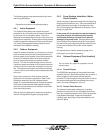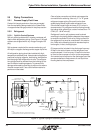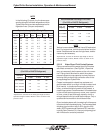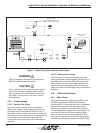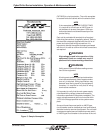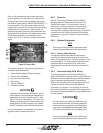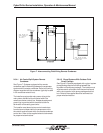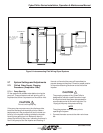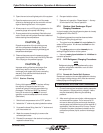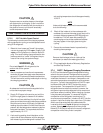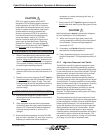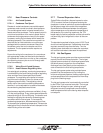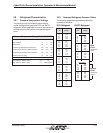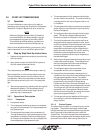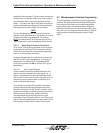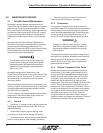
(©October, 2006)
CyberChiller Series Installation, Operation & Maintenance Manual
2-10
2. Open the vent valve at highest point of the system.
3. Open the water source and run until the water
solution is discharging from the vent with minimal
signs of foaming due to air in the system.
4. Allow pump to run until 30 psig is indicated on the
pressure gauge at the pump inlet fitting.
5. Ensure water side is completely filled without air
voids. Check and verify proper flow rate is obtained
before starting the compressors.
CAUTION
Extensive operation of the circulating pump
with the compressors disabled may cause
damage from the abnormally high water/glycol
temperature developed.
5. Observe the pressure on the pressure gauge
connected to the chiller pump inlet fitting. Maintain
20 to 30 psig on the pressure gauge.
CAUTION
Improper setting of the heat exchanger flow
switch may result in freezing of the heat
exchanger, and system failure not covered by
warranty. Only qualified individuals should
perform this procedure.
2.7.1.2 Strainer Cleaning
NOTE
During initial operation the “Y” strainer will trap
the majority of the particulate left in the
system as a result of various manufacturing
processes. The Strainer MUST be cleaned
every 30 minutes during the first 3 hours of
operation to ensure adequate flow of coolant.
(See below.)
1. Switch both compressors to the “OFF” position.
2. Isolate the “Y” strainer by closing isolation valves.
3. Unscrew the brass fitting from the “Y” strainer and
pull the screens out.
4. Wash the screens thoroughly to remove the
collected particulate.
5. Reinstall the screens in the strainer housing and
replace the brass fitting.
6. Re-open isolation valves.
7. Resume unit operation. Repeat steps 1 – 6 every
30 minutes for first 3 hours operation.
2.7.2 Outdoor Heat Exchanger Glycol
Charging Procedures
In glycol cooled units the refrigerant system is already
charged with R-22 or R407C.
The following precautions must be observed when
installing and filling the glycol loop:
• The glycol must be mixed with water before it is
added to the system. All air must be bled from the
piping system.
• The piping system must be cleaned prior to
adding the glycol solution to the system.
• Use only water glycol solution with inhibitors for
corrosion protection.
2.7.3 R-22 Refrigerant Charging Procedures
NOTE
Refrigerant charging must be performed by a jour-
neyman, refrigeration mechanic or an air condi-
tioning technician.
2.7.3.1 Remote Air-Cooled Split Systems
Remote air-cooled units come equipped with a factory
dry nitrogen holding charge, which must be removed
before piping and charging the unit.
PREPARING SYSTEM FOR CHARGING
1. Once all connections have been made, pressurize
the system to 150 psig with dry nitrogen. Leaks
may be detected by observing the standing
pressure.
2. After ensuring there are no leaks, relieve pressure
and evacuate the system. Pull a vacuum of 50
microns or less using the suction and discharge
service ports and the service port of the receiver (if
applicable). Hold the vacuum for 2 hours. Ensure
no portion of system has been isolated from the
evacuation process (liquid, suction or discharge
lines).



